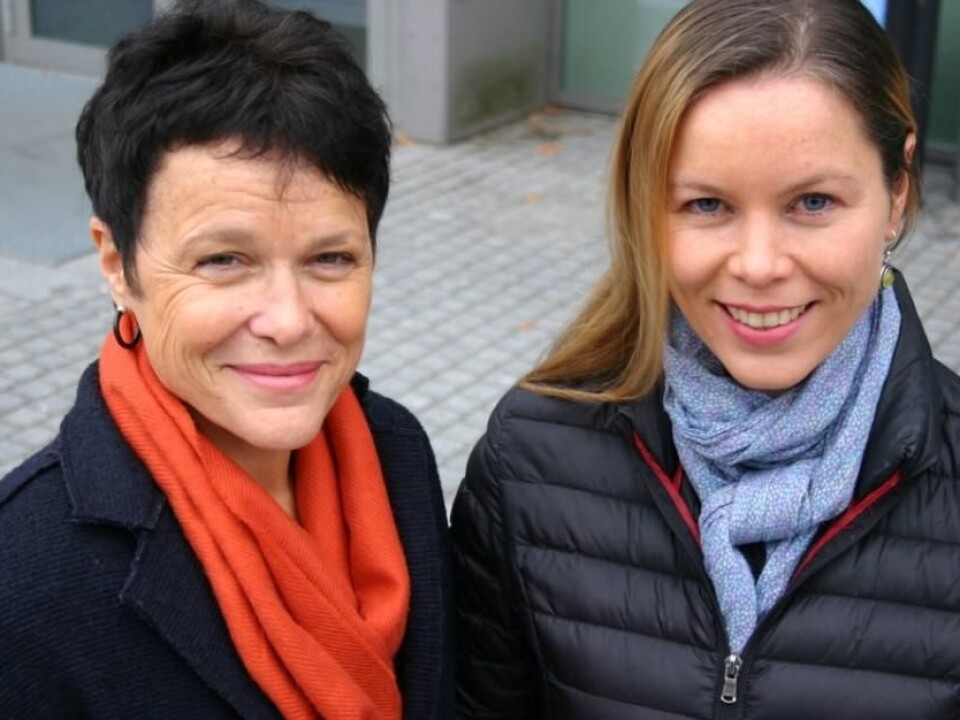An article from KILDEN Information and News About Gender Research in Norway

When sex becomes impossible due to burning pain in and around the vulva
Women with vestibulodynia feel that they’re missing out on the wonderful sex that the media boasts of. And they’re ashamed of being poor sexual partners.
“I’ve always had pain during sex, ever since the first time,” says a 23 year-old woman. “It destroys your sex life in a way. He thinks ʻAll I’ve done is to inflict pain on herʼ. So it’s not something you want to tell your boyfriend.”
When the researchers interviewed women about their experiences with vestibulodynia – burning sensations at the entry to the vagina caused by touching or penetration – one issue was particularly emphasised.
“Being a sex partner. That’s what they talked about. They talked about this on their own initiative, and they had a lot on their hearts,” says Karen Synne Groven, researcher at the University of Oslo and Oslo and Akershus University College of Applied Sciences.
“They probably don’t have many others to talk to about these issues.”

Groven and her colleague Gro Killi Haugstad from Oslo and Akershus University College of Applied Sciences are two of the researchers behind a study of eight women between the age of 23 and 32 who are all being treated for vestibulodynia. It is one of few qualitative studies which explores how women themselves experience their own disease.
Sexual intercourse painful or impossible
The eight interviewed women realised that something was wrong when they had their first sexual intercourse.
“I don’t know whether they had experienced pain earlier when they were masturbating or using a tampon. But it was when they started to have sex that they first became aware that this wasn’t normal,” says Groven.
For one of the women it was impossible to go through with sexual intercourse.
Another woman thought that maybe she was too small down there, or that maybe she felt pain because she didn’t dare to say no when she didn’t really want to have sex. But then it kept happening again and again. And sex became stress related.
One wondered if it was because she was unprepared and not relaxed enough. “I thought it was just a starting problem. I started to have regular sex with my new boyfriend. But it never became comfortable.”
Taboo and lack of knowledge
“The first women I met who had this, told me that they didn’t want to talk about it, it was too tabooed,” says Haugstad, who has treated nearly 100 women with vestibulodynia.
“They were often given medication meant for vaginal yeast infection. When that didn’t help they were given a new cure.”
After some time, gynaecologists started to refer the women to the policlinic at the Department of Physiotherapy at the Oslo and Akershus University College of Applied Sciences. Some studies have shown that women with vestibulodynia find it difficult to relax their pelvic floor muscle.
This is how Groven and Haugstad, both physiotherapists and researchers, became aware of the phenomenon.
Miss out on the wonderful sex
In order to check whether a woman have vestibulodynia, gynaecologists normally use a Q-tip to touch the painful area in the entry to the vagina, or the women themselves try to insert a tampon and tell the gynaecologist how it feels. The tampon consumption among women with vestibulodynia is naturally very low. Some may experience pain just by sitting on a bike, or by swimming against the currents.
But it was the troublesome sex life that mostly preoccupied these women.
The researchers emphasise that culture is not the only reason why the women to talked so much about sex. It has to do with both body and culture.
“It has to do with the desire for intimacy and to experience pleasure. They really want to have sex , they feel that they’re missing out on something that they hear others talk about, something they’ve rarely or never experienced themselves,” says Groven.
“These women are young, and in is the age when you are expected to experience big things sexually, and so much is written about how fantastic this is. They are extremely disappointed; it is such an enormous disappointment to realise that they can barely be touched,” Haugstad adds.
Feel guilty for partner
In addition to today’s sexual norms telling us that we all should enjoy sex and have all the sex we desire, we should also, ideally, satisfy our sex partner.
One of the women in the study had been married twelve years without having been able to go through with sexual intercourse. Another one broke up with her boyfriend because she couldn’t handle the pressure. Two of the women were single, and were reluctant to date; it eventually leads to sex, which they weren’t able to have.
They all felt guilty for not being able to be satisfactory sex partners, and they all felt like they were not true women, since they were unable to have penetrative sex. Several were worried that they wouldn’t be able to become pregnant or give birth.
Aware of own limits
Although today’s media and sexual norms have a strong focus on sex, there is, at the same time, a lot of talk about boundaries.
“You’re in charge of your own body, that is also a part of today’s sexual norms. One current theme is that it’s OK to say no,” says Groven.
“These women are very aware of their own limits. They don’t just lie there and allow things to happen. They say that this isn’t working, it is too painful.”
“And the men are there for them,” says Haugstad.
“Six of the women are in relationships. He doesn’t leave them.”
However, studies of male partners of women suffering from vestibulodynia are not an abundance. Haugstad and Groven are not aware of a single one.
New but widespread diagnosis
Pain in women’s vulvar area is nothing new, and perhaps neither is vestibulodynia. Knowledge about women who can’t have sex due to vulvar pain goes far back in time. But the medical term vestibulodynia is new.
Exactly how new is difficult to determine. According to Haugstad, vestibulodynia has been the focus of research over the past decade. Special interest organisations were established in the U.S. in the 1990s.
Vestibulodynia does not yet show on blood tests. The theory that it is caused by vaginal yeast infection has been abandoned by many researchers today. Some have red skin on their vulvar area, others don’t. Some manage to experiment and find sexual positions that work for them; others can’t have penetrative sex at all.
The major variation concerning experiences with vestibulodynia may be one of the reasons why it is so difficult to say anything specific about how many women are affected.
Groven and Haugstad operate with the figures 4-28 per cent of all women between the age of twenty and forty.
“In comparison, between 7 and 10 per cent of the population have back pains at all times, which is something people talk about a lot,” says Haugstad.
“Many women suffer from vestibulodynia, but very little is written about it.”
Specific, burning pain
Since we don’t know why women get vestibulodynia, the disease is perceived as diffuse. It is psychologised and theoreticised, and is often linked to the stressful lives of today’s women.
“But this pain is very real,” says Groven.
“And it is very specific. These women can find areas that are more painful than others. They describe it as a burning, prickly pain. From the metaphors they use to describe it, it sounds like an infection or an inflammation. There might be something here that we don’t see or detect through medical tests and examinations.”
Does vestibulodynia affect “clever girls”?
According to the Vulva Policlinic’s home page, “Many women with vestibulodynia have a high stress level and would benefit from practicing stress management.”
“This is something everyone is told, it seems,” says Groven.
But although Haugstad has definitely met women who fit into the clever-stressed-girl stereotype, Groven emphasises that none of the eight women in the study live particularly stressful lives.
“They weren’t more stressed than other girls in their twenties. They weren’t extremely preoccupied with fitness and training, some of them studied, some worked, none of them worked particularly hard in their spare time. There was much more diversity than what I had imagined when I read about this in the media.”
“But when they’re told that they’re stressed, they start thinking about stress in everything they do. They start looking for the stress.”
“At the same time, these women feel insufficient, which is also a type of stress,” Haugstad points out.
“They don’t feel like true women, they can’t have sex. They think about this a lot, some more or less all the time. It’s a mental stress that may contribute to the persistence of these pains.”
Invasive questions about abuse
In accordance with the assumption that these pains may derive from psychological issues, several studies have examined whether there may be a connection between sexual abuse and vestibulodynia.
All the eight women in the study had been asked what they experienced as invasive questions concerning whether they had been sexually abused.
“None of them had experienced this, they were very clear on that,” says Groven.
“We don’t know for sure if there are more people with experiences of sexual abuse among those suffering from vestibulodynia than among people suffering from other long-term pains. This is also something which may be very difficult to talk about and bring to light,” says Haugstad.
Treatment that works
One of the women in the study has found ways to have sex that don’t involve penetration and that make men find her exciting as a sex partner. Another has found positions that are less painful, which both make her capable of having sex and sometimes even feel pleasure.
“These are active women. They seek help, and they have often diagnosed themselves by the use of google and others suffering from vestibulodynia with whom they’ve communicated online before they see a gynaecologist,” says Groven.
“They don’t give up, they don’t just accept their condition, they keep trying. Both in the relationship and on their own.”
The good news is that various kinds of treatments seem to work. Not the creams prescribed by most gynaecologists and not vaginal yeast treatments. But a combination of muscle relaxation, practicing body awareness with the help of a physiotherapist, consultations with a sexologist, or, perhaps the most drastic treatment, an operation.
Groven and Haugstad are already working on a scientific article about the treatment of vestibulodynia.
“Studies show that for several of these women this is something that will pass in due time,” says Haugstad.
“It often takes two to three years, and that is of course an extremely long period. But they do get better.”
——————————————————-
Read the Norwegian version of this article at forskning.no
Translated by: Cathinka Dahl Hambro



































